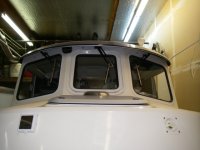knot flying
New member
I have a 22 foot C-Dory Cruiser. I am installing shore power and I am looking for any suggestions as to the best position to put the shore power inlet.
knot flying":3iheoe6i said:I have a 22 foot C-Dory Cruiser. I am installing shore power and I am looking for any suggestions as to the best position to put the shore power inlet.

Socrateur":3sltt33y said:there were two marinas where I could not reach the shore power with my gunnel mounted 25' cord whereas this boat could.
DaveS":23xowfpl said:(So far, I haven't had to connect the two to create a 75 footer.... :roll: )
Sneaks":36118e5g said:Uh what sort of connector do you carry that allows you to create the longer cord, Dave? My shore power cord has that big 30 amp marine shore power connector at one end and a standard 3 prong 20 amp receptacle on the other end. More importantly, where did you buy it?
Any chance we could see how and where you mounted the charger between fuel tanks?
